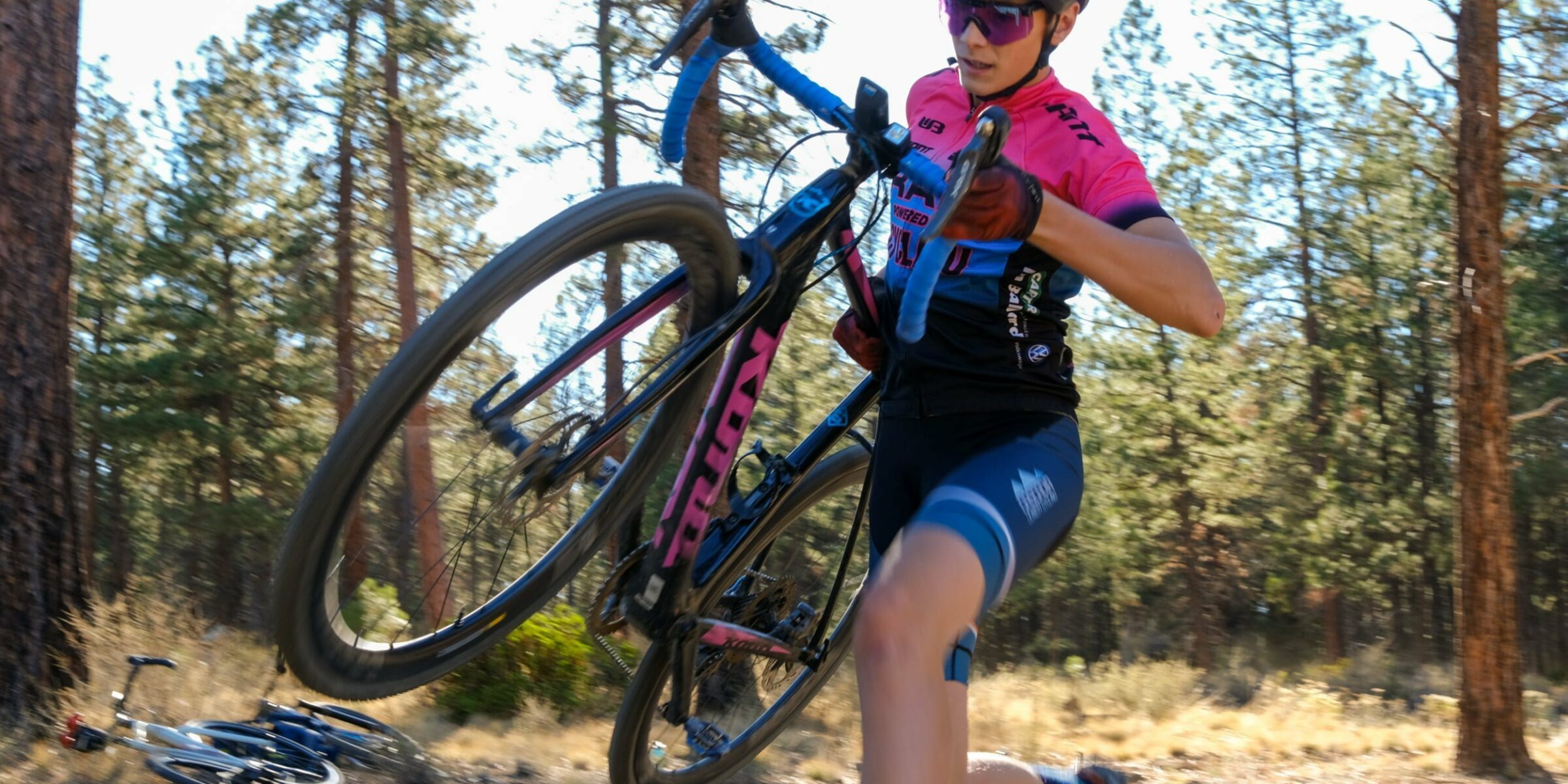Several of our riders are now training with power, so we’ve been able to expand our vocabulary to incorporate some really great concepts into our training for all racers on the team.
Heart rate data shows how each rider responds to the load of the training — but because heart rate is attached to all the other systems in the body, it’s difficult to give objective answers regarding their curve. Everything in an athlete’s body, environment and mental state affects the heart rate curve. It’s good for tracking long endurance rides and for establishing a base line of health or fitness over the training block, but it’s not very good for prescribing workouts other than for recovery.
Heart Rate Lags
Because heart rate so variable, I cannot reliably instruct a group to go “ride in heart rate zone 4” because it’s very challenging finding that steady state on a cyclocross bike or mountain bike, especially in a group — they keep over-shooting and then rest too much, so I’ve been simply using HR as a way to record their body’s reaction to the strain and set limits for when I don’t want them over-reaching during a recovery or rebuilding workout.
The lag is even worse during competition because many riders experience a much higher HR at the start due to nerves and excitement, then they feel ok following their attacks for the first part but when they see higher HR than normal they begin to question their tactics, making them more anxious / nervous, or at least distracted — so we’ve been adapting out terminology to talk more about concepts based around breathing rate and power-based training for performance & building workouts.
Breathing Offers Control
We’ve been incorporating several kinds of helpful breath-work techniques to increase each rider’s sense of control during training and competition. One example from training is combining nasal breathing with counting the seconds for each inhale and exhale. This slows down their breathing and recruits proper muscular timing / patterns so their bodies can exchange oxygen / CO2 more efficiently — this has nearly eliminated once common incidents of ‘exercise induced asthma’ and hyperventilation in my athletes because they now have underlying knowledge of how their bodies work so they can push the limits without fighting their physiology.
In competition, the breath rate is directly controlled, whereas HR is a response. The ability to find a resting posture, center on the breath and get back into the flow of the race is critical for riders who want to attack and push their limits over the entire duration of the event. Identifying, naming and practicing these techniques has been very helpful for our team’s development.

Power is the Goal
Wattage is the actual measure of work that a rider is doing at the moment, meaning we can reproduce race efforts in training and learn to match up their subjective feelings with the actual response their bodies are producing or capable of producing. Many people are familiar with the term “threshold” in endurance training, usually referring to one’s average power or heart rate for a 60-minute time trial or 95% of a 20-minute test, but this emphasis on the 60-minute limit is often inadequate for junior cyclists focused on XC, Enduro and Cyclocross. Because a riders’s FTP (functional threshold power) is an average, nearly all off-road races are paced well above that threshold while on the gas because there’s some rest on the backside of the hill — so how do we know how to manage that pace in the attack? Too much effort means a rider won’t recover, while too little means they won’t hit their target pace.
To help us with this, we’ve been talking more about our Functional Reserve Capacity (FRC) as described by Tim Cusick as your “anaerobic battery” — it’s a concept that our juniors have really benefitted from because it matches up so well with their intuitions. I was taught to think of my race attacks as a book of matches that you can light as the race unfolds, but you never really knew how many matches you had left, nor how many you needed to burn in training to increase your potential. This is how the FRC model helps us.
How we apply power-concepts for everyone
One example is today’s workout that was broken into three parts:
AHAP PMAX SPRINTS: while fresh, everyone did 5 – 7 AHAP sprints (as hard as possible), going for PMAX (power maximum) for about 10 seconds each. We used a hill that gets steeper at the top, a stiff gear and a lot of grit. Recovery was at least 2 minutes between efforts to allow good recovery because adaptation is more important than just accumulating stress. While every effort is AHAP, the entire segment feels relatively easy and HR stays quite low. This chart below shows “energy supply” in the blue line up top, with power at the bottom. See how the first 5 sprints starting around 45 minutes made a significant hit in this rider’s energy supply, each one going deeper into the energy reserve, but after a few more minutes of riding his anaerobic capacity is back up to normal levels. This is how I’ve always trained my juniors but I didn’t have this data or terminology to back it up, so TrainingPeaks and WKO+ have been very helpful.

WKO+ has a “Visual Matches” chart that helps us see exactly how these efforts add up in a race or training. This is a corresponding chart for the workout above, showing at least 15 “matches burned” in this training ride. Technically, this is the rider utilizing an anaerobic energy pathway to produce these short bursts of high power.

Then how many matches does one need to burn? Like HR, motivation can play a big role in how hard a rider can push, so let’s compare the training ride above with a race, below. This was the same rider’s chart from winning his Nationals short track race, showing over 20 matches burned in 30 minutes, which is a severe rate of a full-power attack every 90 seconds. This requires very good lactate production / clearing, breath control, posture, muscular endurance, tactics, timing, etc. A misplaced match can absolutely have a negative impact on the entire race. This is why we train with a few types of micro-intervals like 15-15’s or 30-30’s to build our FRC capacity and become more comfortable with recovering after attacks.

And this chart below is from a national-level cyclocross race (missing data from changing bikes for a lap), but it clearly shows a rate of about one match burned per minute. Not much time to recover FRC at this rate — the battery is draining quickly and recovery from this effort will take days, not minutes. My theory is that these efforts are very demanding but the automated training stress score (TSS) doesn’t always reflect the higher difficulty on these shorter rides, so I err on the side of caution when training / depleting FRC that we need extra time to recover after these bouts. If it’s a general rule that 100 TSS = 24 hours recovery, I see that if FRC was fully depleted in that effort it can almost double the recovery time, as reported by the juniors experiencing it.

Seeing the kinds of efforts he needs to stay with the group, and the rate of attacks, this rider can now have a much more productive & informed training block to build the “FRC battery.” These concepts also help us have conversations with everyone on the team about tactics, training, preparation — and create goals and landmarks for juniors of various ages and abilities to achieve as they grow, mature, and gain experience from racing about their bodies, their sport, their strengths and weaknesses — both physical and mental.
In addition, for Cyclocross, it’s complicated by being able to choose the JR races of 30 – 40 minutes in length vs the adult races of 55 to 65 minutes in length. If a junior rider is accustomed to a full attack every 60 seconds then he or she might not have enough FRC to make it past 45 minutes in the adult race. Therefore, the rate or the intensity, or both, must drop. Add that to the pressure of racing with adults and that can really disrupt a rider’s perceived progress.
Oh, and what do we learn from the heart rate chart? It’s pretty much a flat line, so it tells us his body was stressed, but that’s about it 🙂 We’ll use HR in the recovery ride to ensure the riders don’t place too much additional strain on their bodies.

Part 2 of today’s workout was ramps from an RPE (rated perceived exertion) of 7 up to a 10/10 over 40 – 60 seconds. These ramps simulate race efforts, build FRC by depleting the battery in a controlled manner, which gives riders a chance to practice better breath control during the short maximal effort followed immediately by focused recovery. Recovery is a skill, so I coach the riders not be passive — focusing on breathing properly with helpful postures or movement helps our bodies stabilize faster and perform better.
Part 3 was a secret blend of skills and drills to further encourage adaptation, make training fun, and give each rider positive feedback about their progress.
While it’s easy to imagine that data will help a rider get better, it’s only the aggregate of the data that helps us point the rider in the right direction, and most of it doesn’t need to be seen or explained to the riders as long as the concepts are in place for them to follow. Their performance gains don’t come from watching their heart rate monitors as they suffer through a training ride, but rather are the result of adaptations created by the integration of gaining knowledge through challenging experiences, combined with the strength gained through demanding, intentional, controlled physical effort.
None of this means anything unless it’s fun. Learning, experimenting, competing, adapting — these are the aspects that keep us engaged and curious to keep trying.



